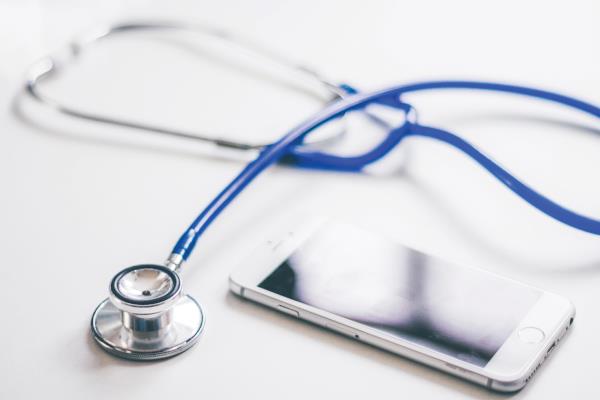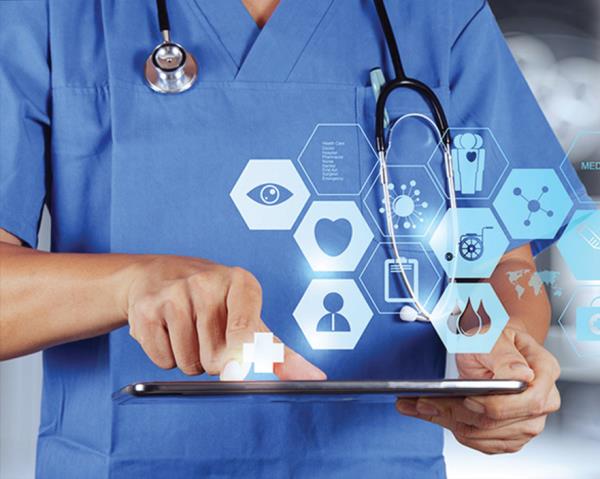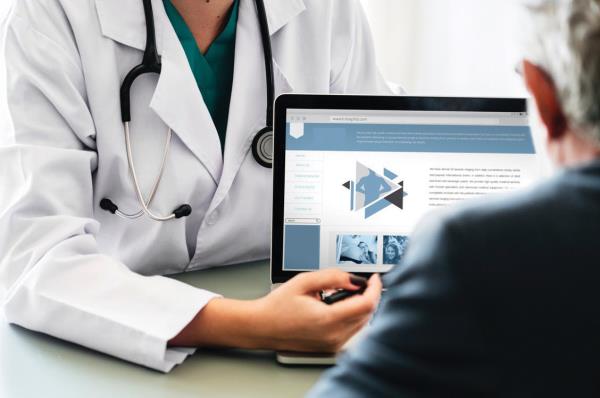05 November 2019

The Internet of Things (IoT) is a staple term in the IT and communications lexicon. It makes sense because as workers and consumers we use it every day, whether it’s connected security systems, thermostats, cars, electronic appliances or vending machines – if you’re lucky enough to have one.
However, it’s not only being championed as a technology that can help us around the house and workplace (also see feature, May 2019 issue), it also has, for want of a better expression, “health benefits”.
Huw Owen, head of EMEA & APJ at database company Couchbase says when IoT – he refers to it as Internet of Medical Things (IoMT) – “is done right”, it allows medical organisations to deliver healthcare in ways that “simply weren’t possible” before. “This is because the IoMT enables them to capture and share a huge volume of health data across a variety of ecosystems, from patients, to care providers, to pharmacies, to medical technology companies,” he says.
“The benefits of IoMT range from cost efficiencies, for example when it’s used for patient monitoring, to allowing faster and more reliable access to patient records outside of traditional care facilities, accelerating treatment or diagnosis of patients at-the-scene and even offering caregivers the ability to use medical devices where internet connectivity may be a challenge, such as in remote areas.”
Indeed, bringing the point-of-care closer to the patient is a must when looking to improve long-term disease management and Owen is convinced IoT can help deliver this.
“To reap these benefits, medical devices and MedTech applications need to be underpinned with a data architecture that enables them to perform as promised in “the real world” and be flexible enough to meet changing requirements without creating disruption, for example, if regulations were to change,” he continues.
Owen speaks from experience, too. As an ex-rugby player, he’s “seen first-hand” how disastrous a delay in diagnosis of head injuries can be. “To combat this, (neuro-technology company) SyncThink has developed a VR headset and tablet-based application that tracks eye movements in athletes and soldiers and helps medical professionals to identify eye-tracking impairments, which is a common symptom when someone has experienced a brain health injury.”
Since internet connectivity isn’t always guaranteed “in-the-field”, SyncThink relies on Couchbase’s NoSQL database technology for mobile devices, which enables it to run assessments even when the device is offline. Doctors can capture results and sync the data to a central data store when connectivity returns. Professionals can then quickly determine whether an athlete can stay in the game or requires additional medical attention.
Daniel Beeler, chief technology officer at SyncThink gives an example of where the partnership with Couchbase is already working. “In large stadiums, tens of thousands of fans might be using smartphones and that can reduce available bandwidth,” he says. “We need a data platform with offline functionality so team doctors can conduct assessments on the side-lines and then seamlessly sync with the Microsoft Azure cloud environment when sufficient bandwidth becomes available. We wanted a NoSQL data platform and Couchbase met all of our requirements.”
Modernisation as well as access to modern technologies for the healthcare sector can be critical to improving its day to day operations
Owen cites MedTech company Becton Dickinson (BD) as another example, in that it uses connected medical devices and a mobile app to enable diabetic patients to track their insulin and glucose levels from home. The app provides patients with customised alerts and recommendations and provides doctors with access to this data to monitor their health in real-time. “BD had to overcome inconsistent internet connection for patients, not to mention the sheer volume of individual medical data that health professionals must interpret,” he says. “Mobile database capabilities have helped BD here – by allowing patients’ data to be constantly streamed, accessed and analysed, even from locations that don’t have a constant internet connection.”
Danny Itzigsohn, senior director, technology and strategy at telecom software company TEOCO points to the fact that telemedicine is one of the fastest growing IoT verticals and so IoT can play a massive part in helping with figures alone. “The number of patients being monitored remotely is projected to exceed 50 million by 2021,” he says. “As population size continues to grow, life expectancy is also on the rise. In 50 years’ time, the Office for National Statistics has projected that an additional 8.6 million people will be aged 65 or over in the UK – a population roughly the same size as London. As this ageing population continues to expand, so too does the number of people with chronic diseases – which will require constant monitoring of their medical conditions. For example, according to the American College of Cardiology, more than 20% of heart failure patients are readmitted within 30 days and up to 50% by six months.”
For that reason, Itzigsohn believes telemedicine could be the solution to help manage what he describes as the “growing and looming reality” facing humankind.
“Remote patient monitoring (RPM), a crucial part of telemedicine, allows for the monitoring of patients outside of conventional medical scenarios, for example, in a patient’s home,” he adds. “Using RPM, doctors are able to connect to their patients through different forms of communication including video conferencing, smartphones and even smart devices. RPM therefore helps to drive down hospital readmission rates, resulting in more cost-effective treatment.”
So, the benefits of treating patients remotely are clear and easing the pressure on a struggling National Health Service (NHS) is only ever going to be a good thing. However, most of the time one needs to see a medic in the flesh when there’s an existing health issue, so what happens then?
“It can also reduce initial hospital visits for patients with chronic illnesses, like diabetes, heart disease and even obesity,” Itzigsohn says. “For instance, if RPM is enabled through reliable wearable technologies that transmit patient vitals and symptoms to medical hospitals and offices, it could serve to alert medical professionals of impending issues before the patient ever has to resort to hospital or emergency room services – initially or subsequently. IoT devices can therefore play an important role in helping doctors analyse how their current activity could be impacting patient health and to reach the root cause of a medical condition much faster to provide a timely diagnosis.”
Steve Killick, product manager at enterprise solutions firm WiFi SPARK agrees and says one of the most effective implementations of IoT is happening right now in the wearable technology sector. He points to the recently launched Samsung S-Patch 3, a compact heart monitor working to an ECG standard.
“If a patient visits A&E after experiencing chest pains, medical staff can issue the S-Patch 3, which is quickly placed on their chest,” he adds. “As the patient is in the waiting room, the S-Patch 3 will collect real-time electrocardiogram data. Once in the consultation room, the doctor will have access to this data, empowering them to diagnose the patient, not only quicker but more accurately, as the S-Patch 3 will have been monitoring the patient’s heart rate for the duration of their visit. Once discharged, patients can also be issued with the S-Patch 3, giving them and medical professionals access to real-time updates on their condition.”
Another influential benefit to the healthcare industry, says Killick, is extraction of real-time, continuous data. “Medical data is currently collected manually by a healthcare professional and is collected at regular intervals (depending on the patient’s condition and their National Early Warning Score),” he says. “As anyone who works in the healthcare sector knows, everything can change in an instant and a snapshot overview of a patient’s condition can be outdated the moment it is processed, let alone, two, four or eight hours later.”
Killick adds that in addition to the all-important 24/7 patient monitoring, IoT will catch any abnormal readings as they happen—preventing major health issues before it’s too late. “By the same token, it will also relieve the strain on healthcare professionals who are carrying out manual checks on stable patients and will free up staff to attend those with more serious conditions.”
Indeed, helping staff to do their jobs with far more ease and less complication is a no-brainer, says Rashid Ali, UK enterprise sales manager at Wallix, the European cyber security software company and specialist in privileged access management (PAM) “Within a single healthcare organisation such as a local hospital, there can be hundreds if not thousands of employees,” Ali says. “These include doctors, nurses, research teams and administrators as well as external third-party providers. IoT applications and devices have the ability to enable collaboration, supporting the teams and providing critical access to information at the touch of a button. There is no denying that IoT has the ability to modernise the healthcare sector and patient care. But this needs to be done with consideration as IoT can also pose a number of risks when it comes to data and access management.”
How will our sensitive medical data be handled in the future?
Ali adds that modernisation as well as access to the aforementioned technologies for the healthcare sector can be critical to improving its day to day operations. “Alongside collaboration, IoT can bring a range of significant benefits such as more accurate health monitoring, sensor alarms and electronic health records for quick and easy access,” Ali says. “Fundamentally, IoT will open the path to more data access, which is a huge advantage when it comes to improving health services.”
Killick argues that another huge market for IoT will be within social and community care, which is a key component of the "NHS Long Term Plan”. He says: “Part of the plan states: ‘By the end of the 10-year period covered by the plan, the vision is for people to be increasingly cared for and supported at home using remote monitoring (via wearable devices) and digital tools’. This will lead to huge cost savings to the NHS, it will benefit us all in many ways and it is yet another indicator IoT is hugely important to the future of healthcare.”
The future does look and sound promising, but where are the examples of where IoT is already making a difference?
“IoT is already working well for many local GPs across the UK,” argues Ali. “For example, when it comes to booking an appointment or moving to see a specialised consultant most records are transferred electronically. This allows experts from numerous departments and from across the world to collaborate and share information instantly. And this is just one small case. As IoT starts to become more widely rolled out we will start to see a significant change. However, it’s important to note that the departments that are integrating IoT well are the ones that have assessed the security risks.”
It’s difficult to argue against IoT being a game-changer, but given the amount of times the word “data” has been used, isn’t there a terrible risk IoT is playing into hackers’ hands? After all, it has been well-documented in the media that international health administrations are already issuing guidelines that must be strictly followed by governmental medical establishments integrating the IoT in their workflow. Surely, these restrict possible capacities to some extent?
“Security, for obvious reasons, will need to be highly regulated with the advent of IoT in healthcare,” says Killick. “With IoT, more patient data will be collected than ever before, and it is vital this information doesn’t fall into the wrong hands. Many applications of IoT will be deployed using Wi-Fi networks, due to their wireless and interoperable capabilities, which makes secure enterprise-grade networks essential. Being able to authenticate devices, combined with real-time analytics, will ensure that individual devices are able to connect to networks and transmit the ‘expected data’.”
Killick also argues that “to date” the security of networks hasn’t been taken seriously. “To illustrate the severity of the problem, a researcher actually hacked into a pacemaker and turned it off,” he says. “Insulin pumps have also been hacked, forcing them to inject their full supply in one go. So, having a secure Wi-Fi network is critical to the successful implementation of IoT.”
The tech industry has form when it comes to failure to protect data privacy and security of its users. With that in mind, advancements like medical IoT devices and telehealth beg the question: how will our sensitive medical data be handled in the future?
“All healthcare employees have a part to play in protecting patient data,” says Ali. “It’s important to not lose sight of the fact that protecting patient confidentiality is the true goal of IT security in healthcare, not just ticking security compliance boxes. Patient privacy is a key business requirement as much as it is a legal and ethical mandate. In addition, compliance is an important issue for healthcare. Healthcare organisations are heavily regulated by compliance mandates like HIPAA-HITECH, the EU’s General Data Protection Regulation (GDPR), and the UK’s Data Protection Act 1998 (DPA). Non-healthcare directives such as PCI, SOX and others also apply to healthcare organisations in relation to their credit card data and financial reporting obligations.”
Ali says there are policies, strategies and solutions available that can support healthcare organisations on their digital journey. However, he says as part of this, healthcare departments need to think of the three main threats: intentional, unintentional and compromised users. “By implementing restricted access as part of any strategy we will see departments supporting a policy of secure and authorised access only,” Ali says. “This is something that will become pivotal as IoT grows. As a small but vital point of where this is necessary is through the use of MRI equipment. More often than not the connection is to an external third party, and this is where the risk of intrusion and cyber attack is greater as it is outside the control of the local hospital or healthcare department.”
Still, there’s always a chance that dishonest interlopers may access centralised systems and realise some cruel intentions. Then what?
“In today’s digital world there is a growing threat from dishonest interlopes,” says Ali. “But the main challenge in healthcare is safeguarding patient medical records as these have an enormous value on the dark web and black markets. A most recent example of this is the cyber attack in 2018 in Singapore where the data of 1.5 million patients was stolen and this included the prime minister’s.”
So, if a leader of a country isn’t safe from hackers,IoT clearly has a long way to go, but at least it’s saving people’s lives in the meantime. n
-(002).png?lu=245)







